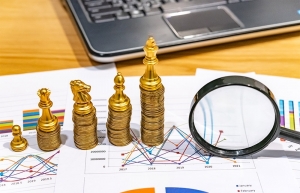Assessing Vietnam’s development landscape through 2024
What is your assessment of Vietnam’s economic recovery this year, and what has been the main driving force?
 |
| Nguyen Thuy Hanh, Standard Chartered Vietnam’s CEO and head of Banking and Coverage |
Vietnam posted robust growth of 6.8 per cent on-year in the first three quarters of this year, and we see an upside risk to our full-year forecast of 6 per cent. Prime Minister Pham Minh Chinh ordered ministries to boost economic growth to more than 7 per cent this year, aiming for Q4 growth of as much as 8 per cent.
The manufacturing sector grew 9.8 per cent during the period and exports rose 15.4 per cent. The growth momentum has been relatively strong.
| Relatively accommodative monetary policy may have also partly contributed to the continued economic recovery so far this year |
Recent monthly macroeconomic indicators – both domestic and external – have been solid, and Vietnam has continued to post a trade surplus. Recent movement in the VND may also reflect the solid trade account, with the currency appreciating to VND24,844 per USD currently from May’s VND25,470 (the weakest level this year).
That said, the ongoing conflict in the Middle East, along with the recent sharp rise in global oil prices, is worth monitoring closely given that it could have an adverse impact on the country’s imports and external account. Other factors that warrant caution on the outlook are the global economic situation, still-patchy China recovery, and a soft-landing of the US economy.
The manufacturing sector is becoming a major pillar of the economy; is this assessment correct?
As stated earlier, the manufacturing sector's growth has been solid so far this year, and its recovery started around mid-2023. The sector has, therefore, significantly contributed to the country’s economic growth. Exports and imports of electronics have continued to recover throughout this year, with September export growth at 16 per cent on-year. Moreover, foreign direct investment (FDI) flows have improved, led by the manufacturing sector.
The sector accounts for almost 70 per cent of total FDI flows to Vietnam. We continue to think that Vietnam is a key link in the global supply chain and an important manufacturing hub for the region. Still, structurally, value addition and the country’s ability to produce inputs locally for the sector could be issues that need to be tackled effectively over the long term. The sector depends heavily on inputs from abroad, so activity could be disrupted by adverse global developments.
Typhoon Yagi has affected the economy. What is your assessment of the impact, as well as support policies to revive development?
The economic impact of Typhoon Yagi in September may not have been reflected in strong Q3 GDP growth of 7.4 per cent. This might be due to solid macro indicators in the earlier months of Q3. That said, September data did show a moderation from the prior month – in trade, retail sales, and inflation. We think this could have a pronounced impact in the early part of the final quarter of the year. Inflation has started to come off, and has now been below 4 per cent for two consecutive months, helping provide some comfort to the domestic economy.
However, the recent sharp rise in global oil prices could complicate the domestic rehabilitation process post-typhoon; this remains to be seen.
We have had many news reports on the typhoon’s severe impact on the manufacturing sector. News flow on the matter has likely turned global investors' attention to the country’s preventive and rehabilitation capabilities.
For Vietnam to remain a key link in the global supply chain, we think it is crucial for the authorities to showcase the country’s capacity to handle natural disasters. Economic acceleration, measures to reduce supply chain disruptions, and the safety of the population in a recovery plan are most important, in our view.
What are your views on Vietnam’s economy in the last quarter of the year, including the possibility of reaching the full-year target? What are the likely risks that the economy faces from now until the end of the year?
It will likely be a challenging period for Vietnam approaching the end of this year. While we see upside risk to our full-year forecast of 6 per cent, we understand that the government is more ambitious, aiming for growth of more than 7 per cent. The lingering impacts of Yagi, a softening global economy, global trade headwinds, geopolitics, rising global oil prices, uncertainty on the pace of Fed rate cuts, and the consequences of the upcoming US presidential election could all create volatility in financial markets and impact the economy. We prefer to stay cautious, but also acknowledge the economy’s ability to perform better than market expectations.
We will also monitor price pressures on the ground. Despite recent downward movements, higher prices for education, housing and construction materials, healthcare, food, and transport have kept inflation above 4 per cent until recently and could remain a source of upward pressure in the forthcoming months. We currently expect a policy rate hike before the end of the year, but acknowledge the risk of no hike as the need to raise rates to help combat VND depreciation may have lessened with the currency strengthening significantly in Q3.
What should Vietnam do to overcome these challenges and promote growth?
We think how the country positions itself amid a potential trade dispute between the US and China will be crucial in maintaining its position in the global supply chain. How the country handles natural disasters will become increasingly important. Managing inflation, as well as monetary policy and foreign exchange volatility, will also be closely watched.
Structurally, issues in the manufacturing sector to reduce exposure to global developments should be effectively addressed with a comprehensive plan. The country may also need to continue to diversify sectors to reduce concentration in the manufacturing sector and attract FDI from other regions over the medium term.
 | The path to managing cryptoasset landscape The crypto market has become a significant income source, but the landscape still needs some clearing up in Vietnam. Dr. Nguyen Nhat Minh and Dr. Thai Trung Hieu, lecturers of Blockchain Enabled Business at RMIT University, look at regulations that are required and how they can be achieved. |
 | Vietnam’s foreign investment landscape in 2024 and beyond Foreign investment inflows into Vietnam have remained exceptionally strong in 2024, and there are clear signs that it will continue to pour into the country for years to come. |
 | Assessing Vietnam’s investment appeal through expert eyes Jimmy Koh, head of network partnerships and strategic marketing, foreign direct investment advisory at UOB, delves into Vietnam's appeal to foreign investments, how UOB supports foreign direct investment (FDI) business expansion and go-green efforts, and the country's FDI prospects for the rest of 2024. |
What the stars mean:
★ Poor ★ ★ Promising ★★★ Good ★★★★ Very good ★★★★★ Exceptional
 Tag:
Tag:
Related Contents
Latest News
More News
- Five tech predictions for 2026 and beyond: new era of AI (December 11, 2025 | 18:16)
- CONINCO announces new chairman and CEO (December 10, 2025 | 11:00)
- How AWS is powering the next-gen data era (December 09, 2025 | 13:14)
- Outlook in M&A solid for Singapore (December 08, 2025 | 10:31)
- Vietnamese firms are resetting their strategy for global markets (December 05, 2025 | 17:04)
- LPBank Securities accelerates AI and data innovation with AWS (December 05, 2025 | 09:00)
- Improving traceability capacity with Zebra Technologies (November 26, 2025 | 10:08)
- Ho Chi Minh City engages 500 CEOs in dialogue on building global megacity (November 25, 2025 | 16:00)
- CEO shares insights on Phu My 3 IP’s journey to green industrial growth (November 17, 2025 | 11:53)
- NS BlueScope CEO highlights decade of sustainable steel efforts (November 15, 2025 | 10:00)



























 Mobile Version
Mobile Version